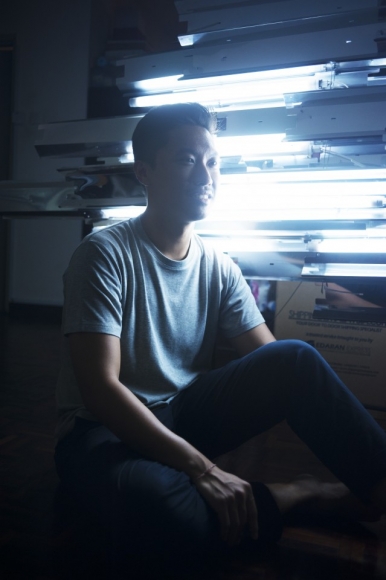From Penang to Singapore, from Hong Kong and on to Sydney, the glorious art of light

A radiant star has landed in Butterworth, a dozy Malaysian port town that is better known as the jumping-off point for Penang island. Made from steel cables and LED light, The Star was created by a young Malaysian artist and architect, Ong Jun Hao, for the Urban Xchange public art festival. The colossal light sculpture spans five storeys of an unfinished building, radiating from its spherical circle to cast a brilliant shine.
-_Credit_Caitlind_r.c._Brown_970_647.jpg)
“The star is a simple but powerful symbol of Butterworth's rejuvenation from a sleepy town,” says the artist.
Since artist Moholy-Nagy led the light art movement at the start of the 20th century, artists have been using actual light as the material and subject. Brilliant and seductive, light art sends out a clear message while retaining a strong aesthetic. As Minimalist artist Dan Flavin once put it, “One might not think of light as a matter of fact, but I do. And it is, as I said, as plain and open and direct an art as you will ever find.”

It has only been a year since Ong returned to Malaysia from the UK, but as one of the very few light artists in the country, he is hitting the sweet spot with several on-site installations, culminating in The Star. The architecture graduate, who has worked with light designer Tom Dixon, finds his expression in a readymade object like the LED tube for his work. “I have always been interested in artificial light for its tangible and non-tangible qualities, its dual nature. I'm obsessed with beauty in artificial objects,” he says.
He will next be exhibiting at i Light Marina Bay in March with an interactive installation called Bolt, inspired by lighting and manipulated by light switches.
__Photo_by_URA_386_257.jpg)
That festival, billed as a sustainable light art festival, returns in its fourth edition to illuminate Singapore’s iconic Marina Bay from 4 to 27 March. The now annual i Light Marina Bay, which is presented by the Urban Redevelopment Authority of Singapore (URA), will feature more than 20 illuminating light art installations from Singapore and around the world.
Key to the festival is the message of sustainability, and the participating artworks are conceptualised and produced with that in mind. For its 2014 edition, Manila-based artist Olivia D’Aboville created a field of giant dandelions made out of recycled water bottles and energy-efficient bulbs. Arup Shanghai created a zero-energy installation using varying lengths of mirror panels attached to cylinders to reflect back Marina Bay’s cityscape and all its attendant illumination.
This year, the festival’s theme takes after Japanese author Junichiro Tanizaki’s In Praise of Shadows, challenging the notion that ‘brighter is better’ and reframing perceptions of light and sustainability.
_Photo_by_URA_386_257.jpg)
It is little wonder that cities make excellent foils for light shows. The towering skyscrapers, iconic architectural wonders and heritage treasures are perfect backdrops for innovative light installations and grand-scale projections. While European cities have long lit up in artistic wonder at light festivals during their long winter nights, Asia-Pacific cities are upstarts in the festival of lights game.
Most spectacular of the new arrivals is Vivid Sydney in Australia. Inaugurated in 2009, with singer Brian Eno lighting the sails of the Sydney Opera House, Vivid Sydney is considered the world's largest festival of light, music and ideas. An Australian winter event, it was attended by more than 1.7 million people last year.
From a light art point of view, it invites some of the world’s best lighting artists, designers and manufacturers to use Sydney's urban spaces as their canvas to work their magic. The results have been gorgeous, creative and illuminating.
In 2015, the ever-expanding festival had 60 light art sculptures sprinkled throughout the city. UK digital art practitioners Universal Everything threw up eye-popping 3D-mapped projections onto the Sydney Opera House, while Spinifex projected a mesmerising mix of images of Sydney's flora and fauna on the solemn facade of Custom House. Thrown into the mix are top-notch music performances and inspiring talks.
This year the festival will run from 27 May to 13 June, when you can expect, among others, an immersive experience with the Vivid Sydney Light Walk. This massive art project will feature more than 40 sculptures and installations on a path stretching from the Sydney Opera House through Circular Quay, The Rocks, Campbell's Cove and through to Walsh Bay.
Over in Hong Kong, from November 2015 to early January this year, three Asian artists have exhibited their artwork themed on light for Supernova X’mas – Luminastic at K11 in Tsim Sha Tsui, conceived in conjunction with the UNESCO International Year of Light 2015.
Local hero Teddy Lo presented Seven Keys, a multi-sensory art experience using light, sound and smell, while Wang Yuyang from China featured a giant interactive moon made up of energy-efficient light bulbs. In keeping with the season, teamLab from Japan created a seven-metre-high 4D interactive Crystal Tree, which used smartphone tech to allow visitors to virtually decorate the tree.
Meanwhile, Hong Kong’s tallest building, the International Commerce Centre, is the canvas for nightly light and sound shows. The ICC Light & Music was recognised by the Guinness World Records for the “largest light and sound show on a single building” in 2013.
The theme and storyline changes with the season, with special editions for the Hong Kong Arts Development Council and Art Basel. Artists Carsten Nicolai and Cao Fei have both used the ICC skyscraper as their palette. The latter projected visuals from popular arcade games such as Pac-Man and Tetris onto the 490-metre-high building for Art Basel 2015. The message of the work was a social commentary on popular youth culture in Hong Kong, a highly visible reference that is as obvious as it can be oblique.
As Flavin opined, light is an art that is as plain and open and direct as you would find.
Main photo credit: © Destination NSW









